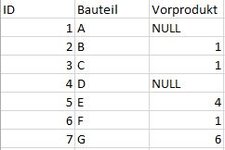Ich habe folgendes Problem ich will eine Recursive Query erstellen die mir die Anzahl der Vorprodukte angibt. Tabelle siehe Anhang
Also das Resultat soll im Prinzip sein :
ID| Anzahl der Vorprodukte
1 | 2
2 | 0
3 | 0
4 | 1
5 | 0
6 | 0
7 | 0
Problem ich bekomme es nur hin das mir SQL ausgibt wer das Vorprodukt ist..
Hat jemand eine Ahnung wie man so eine Abfrage schreibt ?.....
Also das Resultat soll im Prinzip sein :
ID| Anzahl der Vorprodukte
1 | 2
2 | 0
3 | 0
4 | 1
5 | 0
6 | 0
7 | 0
Problem ich bekomme es nur hin das mir SQL ausgibt wer das Vorprodukt ist..
Hat jemand eine Ahnung wie man so eine Abfrage schreibt ?.....

